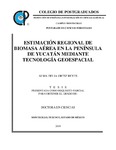| dc.contributor.author | Ortiz Reyes, Alma Delia | |
| dc.creator | ORTIZ REYES, ALMA DELIA; 313154 | |
| dc.date.accessioned | 2020-02-19T17:23:11Z | |
| dc.date.available | 2020-02-19T17:23:11Z | |
| dc.date.issued | 2019-11 | |
| dc.identifier.uri | http://hdl.handle.net/10521/4267 | |
| dc.description | Tesis (Doctorado en Ciencias Forestales).- Colegio de Postgraduados, 2019. | es_MX |
| dc.description.abstract | Caracterizar la distribución espacial e incertidumbre de la biomasa aérea en bosques tropicales sobre áreas extensas es factible mediante el uso combinado de datos de campo, LiDAR (Light Detection And Ranging) y datos espectrales. Se colectaron datos en tres niveles y se empleó una estrategia de modelado que permitió la estimación de biomasa aérea y su incertidumbre asociada a nivel regional, en dos tipos de selva mediana subperennifolia (SMSP) y subcaducifolia (SMSC) en la Península de Yucatán, México. En una primera fase, se relacionaron los datos de campo y LiDAR en franjas mediante regresión lineal múltiple y Random Forest (RF). El modelo de regresión transformado explicó en mayor proporción la varianza para ambos tipos de vegetación, mientras que RF arrojó los valores menores de RMSE. En la segunda fase, una cierta combinación de variables espectrales y climáticas explicaron la varianza en 50% mediante RF (RMSE = 34.2 Mg ha-1 SMSP; 26.2 Mg ha-1 SMSC). Finalmente se evaluó la incertidumbre, a nivel de pixel, mediante el algoritmo Quantile Regression Forests (QRF). Se reportan intervalos de incertidumbre de 0 a 250 Mg ha-1 para SMSP y de 0 a 140 Mg ha-1 para SMSC. Los resultados obtenidos apoyan la idea de utilizar datos LiDAR como una herramienta de muestreo, así como, variables auxiliares de diversas fuentes para estimar parámetros forestales de interés en áreas extensas. Contar con mapas de distribución espacial e incertidumbre de biomasa aérea a este nivel, ayudará a evaluar y proponer estrategias frente al desafío que supone el cambio climático global, sobre todo en bosques tropicales distribuidos en áreas geográficas extensas y dada su naturaleza compleja y dinámica. _______________ ESTIMATION OF ABOVE-GROUND BIOMASS AT REGIONAL LEVEL IN THE YUCATAN PENINSULA USING GEOSPATIAL TECHNOLOGY. ABSTRACT: Characterizing spatial distribution and uncertainty of above-ground biomass in tropical forests over large areas is feasible through combined use of field data, LiDAR (Light Detection And Ranging) and spectral data. Data were collected at three levels and a modeling strategy was used, which allowed the estimation of above-ground biomass and its associated uncertainty at regional level, in two types of tropical forest: semi-evergreen (SETF) and semi-deciduous tropical forest (SDTF) in the Yucatan Peninsula, Mexico. First, field data and LiDAR data in strips were related by multiple linear regression and Random Forest (RF). Second, a particular combination of spectral and climatic variables explained the variance in 50% by RF (RMSE = 34.2 Mg ha-1 SETF; 26.2 Mg ha-1 SDTF). Finally, uncertainty was evaluated, at pixel level, using Quantile Regression Forests (QRF) algorithm. Uncertainty intervals of 0 to 250 Mg ha-1 for SETF and 0 to 140 Mg ha-1 for SMSC were reported. The results support the idea of using LiDAR data as a sampling tool, as well as, auxiliary variables from various sources to estimate forest parameters of interest in large areas. Having maps of spatial distribution and uncertainty of above-ground biomass at this level will help to evaluate and propose strategies to face the challenge by global climate change, especially in tropical forests distributed in large geographical areas and given their complex and dynamic nature. | es_MX |
| dc.description.sponsorship | Consejo Nacional de Ciencia y Tecnología (CONACyT). | es_MX |
| dc.format | pdf | es_MX |
| dc.language.iso | spa | es_MX |
| dc.rights.uri | http://creativecommons.org/licenses/by-nc-nd/4.0 | es_MX |
| dc.subject | Bosque tropical | es_MX |
| dc.subject | LiDAR | es_MX |
| dc.subject | Incertidumbre | es_MX |
| dc.subject | Random Forest | es_MX |
| dc.subject | Landsat | es_MX |
| dc.subject | Tropical forest | es_MX |
| dc.subject | Uncertainty | es_MX |
| dc.subject | Ciencias Forestales | es_MX |
| dc.subject | Doctorado | es_MX |
| dc.subject.classification | CIENCIAS AGROPECUARIAS Y BIOTECNOLOGÍA::CIENCIAS AGRARIAS::CIENCIA FORESTAL::OTRAS | es_MX |
| dc.title | Estimación regional de biomasa aérea en la península de Yucatán mediante tecnología geoespacial. | es_MX |
| dc.type | Tesis | es_MX |
| Tesis.contributor.advisor | Valdez Lazalde, José René | |
| Tesis.contributor.advisor | Ángeles Pérez, Gregorio | |
| Tesis.contributor.advisor | De Los Santos Posadas, Héctor Manuel | |
| Tesis.contributor.advisor | Aguirre Salado, Carlos Arturo | |
| Tesis.contributor.advisor | Peduzzi, Alicia | |
| Tesis.contributor.advisor | Schneider, Laura | |
| Tesis.date.submitted | 2019-11 | |
| Tesis.date.accesioned | 2020 | |
| Tesis.date.available | 2020 | |
| Tesis.format.mimetype | pdf | es_MX |
| Tesis.format.extent | 3,588 KB | es_MX |
| Tesis.subject.nal | Tecnología geoespacial | es_MX |
| Tesis.subject.nal | Geospatial technology | es_MX |
| Tesis.subject.nal | Inventario forestal | es_MX |
| Tesis.subject.nal | Forest inventory | es_MX |
| Tesis.subject.nal | Península de Yucatán, México | es_MX |
| Tesis.rights | Acceso abierto | es_MX |
| Articulos.subject.classification | Bosques tropicales | es_MX |
| dc.type.conacyt | doctoralThesis | es_MX |
| dc.identificator | 6||31||3106||310699 | es_MX |
| dc.contributor.director | VALDEZ LAZALDE, JOSÉ RENÉ; 26273 | |
| dc.audience | generalPublic | es_MX |


